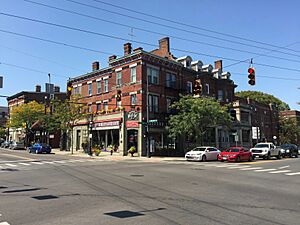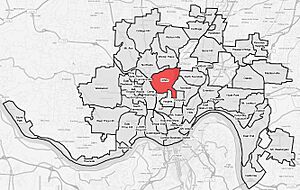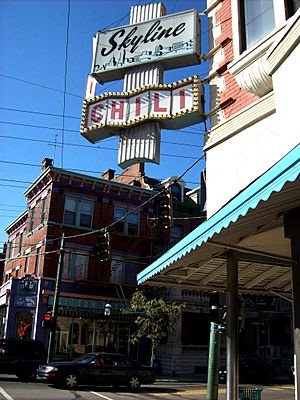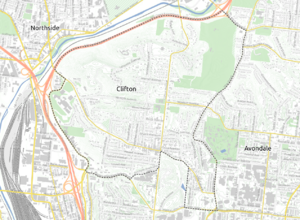Clifton, Cincinnati facts for kids
Quick facts for kids
Clifton
|
|
|---|---|
|
Neighborhood of Cincinnati
|
|

The Clifton Gaslight District
|
|

Clifton (red) within Cincinnati, Ohio.
|
|
| Country | United States |
| State | Ohio |
| City | Cincinnati |
| Population | |
| • Total | 8,408 |
| Time zone | UTC-5 (EST) |
| • Summer (DST) | UTC-4 (EDT) |
| ZIP code |
45316
|
Clifton is one of the 52 neighborhoods in Cincinnati, Ohio. In 2020, about 8,408 people lived here.
This area includes the Ludlow Avenue Shopping and Dining District. Clifton is located around Clifton Avenue, north of Dixmyth Avenue. It is about three miles north of Downtown Cincinnati. Many old buildings and homes are still in the neighborhood. Clifton grew a lot because of the street car system in the late 1800s. Sometimes, nearby areas like Corryville are mistakenly called Clifton.
Contents
Clifton's Past: A Look at History
Clifton became a village in 1850. It was named after the Clifton farm, which was a huge area of hills and valleys. In the 1800s, large mansions with big gardens and parks filled the northern part of Clifton. These grand homes were farther away from the city. Their fancy gates were spread out along Lafayette Avenue.
In the southern part, more homes were built closer together. A busy area with shops and businesses grew along Ludlow Avenue. This was especially true where it met Clifton Avenue.
Designing the Landscapes
Many of the large estates had beautiful grounds designed by Adolph Strauch. He was a famous landscape designer. He also worked as the Superintendent of Spring Grove Cemetery and Arboretum in the 1850s. Later, he helped redesign areas when estates became public parks. Examples include Eden Park and the 89-acre Burnet Woods. Burnet Woods used to be owned by Jacob Burnet.
Changes Over Time
In the 1900s, these old estates found new uses. Some were torn down. For example, a huge mansion designed by Samuel Hannaford was taken down in the 1960s. This made space for an addition to the Clifton School. Only a very old yew tree and the carriage house from that estate remain today.
Cincinnati officially added Clifton to the city in 1893. The University of Cincinnati moved to Burnet Woods Park. Today, the university is in several nearby neighborhoods. These include Clifton Heights, University Heights, Avondale, and Corryville. People often incorrectly call this whole area "Clifton." Hebrew Union College and the Sacred Heart Academy also settled near the university. These schools helped make the neighborhood a place for learning and creative ideas.
Who Lives in Clifton?
| Population of Clifton 1900-2020 | ||
|---|---|---|
| Year | Pop. | ±% |
| 1900 | 2,750 | — |
| 1910 | 4,375 | +59.1% |
| 1920 | 5,450 | +24.6% |
| 1930 | 7,996 | +46.7% |
| 1940 | 8,340 | +4.3% |
| 1950 | 9,205 | +10.4% |
| 1960 | 9,635 | +4.7% |
| 1970 | 10,736 | +11.4% |
| 1980 | 9,240 | −13.9% |
| 1990 | 8,978 | −2.8% |
| 2000 | 8,546 | −4.8% |
| 2010 | 8,304 | −2.8% |
| 2020 | 8,408 | +1.3% |
In 2020, there were 8,408 people living in Clifton. There were 4,653 homes. Most residents were White (62.7%). Other groups included Black or African American (16.0%), Asian (12.7%), and people of two or more races (6.8%). About 4.0% of the population was Hispanic or Latino.
There were 4,118 households in total. About 40.2% of these were families. Almost half of all households (46.4%) were made up of single individuals.
About 16.4% of the people were under 18 years old. Most people (70.9%) were between 18 and 64 years old. About 12.7% were 65 or older. Slightly more than half of the population (51.2%) was male.
For the years 2016-2020, the average yearly income for a household in Clifton was about $52,473. Most adults (70.2%) had a college degree or higher.
Clifton's Culture and Fun Spots

The Ludlow Avenue business district is a special place. It was the first "Main Street neighborhood" in Cincinnati. This means it has many unique local shops, restaurants, and a movie theater. The theater shows independent and foreign films.
The Gaslight District
This area is also known as the Gaslight District. This is because the side streets are lit by original gas lamps. It's a cool feature that gives the area a historic feel. You can find many different kinds of stores and places to eat and drink along Ludlow Avenue.
One famous spot is the Ludlow Garage. This historic building used to be a rock concert hall. The famous Allman Brothers Band even recorded an album there! You can also find Ludlow Wines, which is the oldest wine shop in Cincinnati.
Notable People
- Hulda Regina Graser (1870-1943), a customs house broker born in Canada.
Gallery







